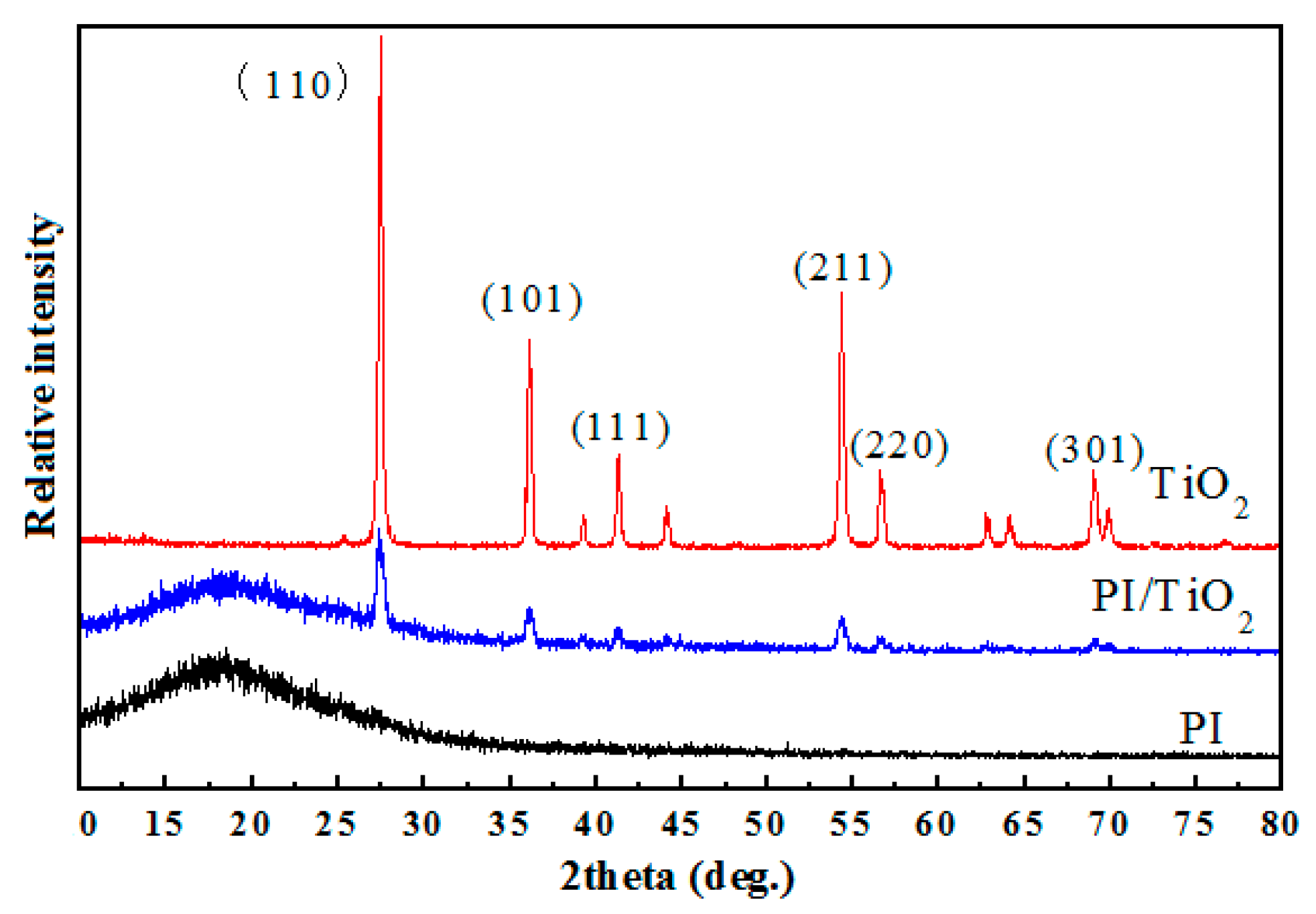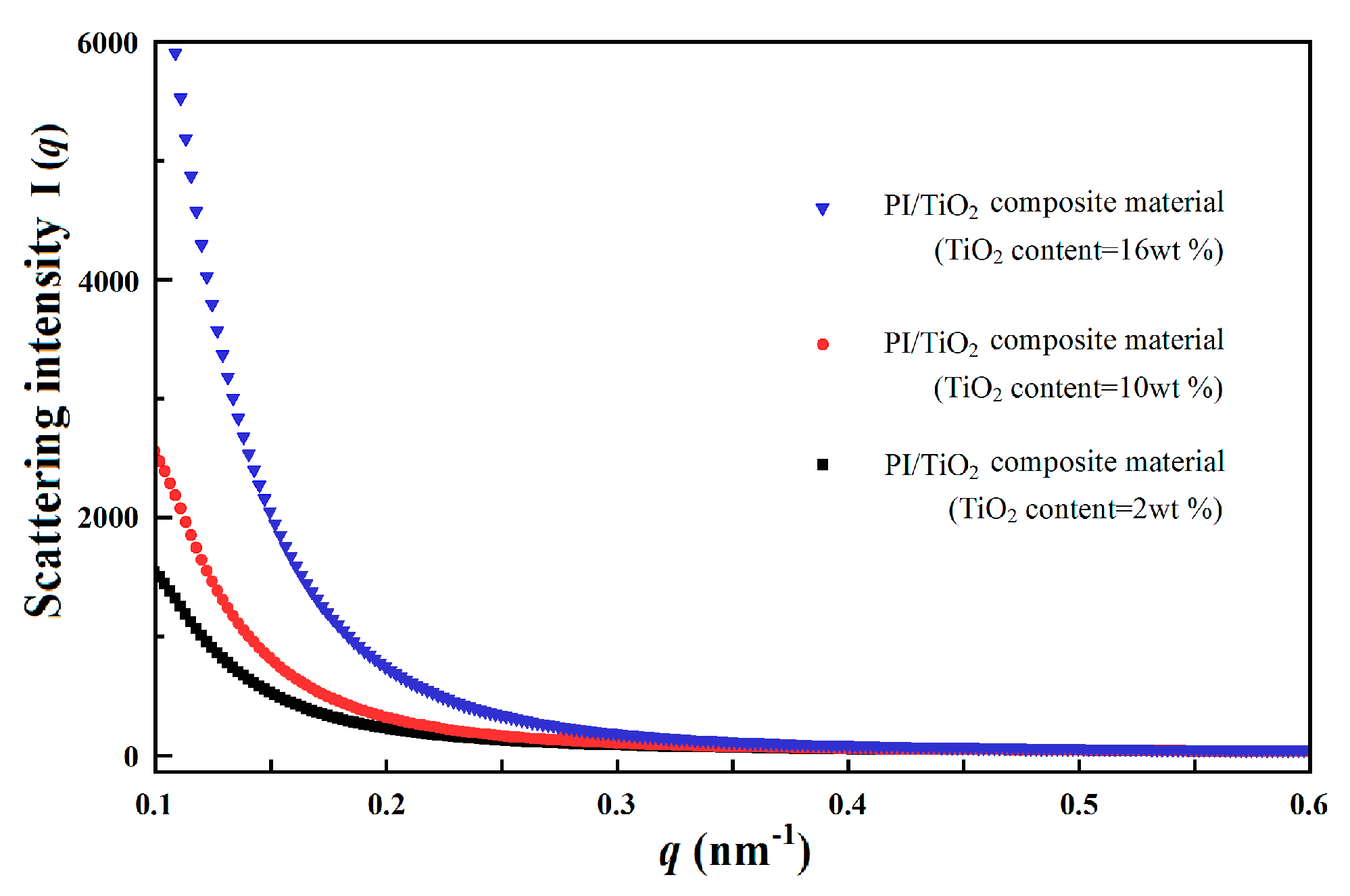Investigation of the Propagation of Electrical Trees in a Polymer Matrix in the Corona Condition
Abstract
:1. Introduction
2. Experimental Section
3. Results and Discussion
3.1. Microscopic Processes in the Initiation of an Electrical Tree in a Polymer Matrix
3.2. Propagation of Electrical Trees in a Polymer Matrix in the Corona Process
3.3. Patterns of Electrical Trees in a Polymer Matrix in the Corona Process
3.4. Improving the Corona Resistibility of a Polymer Matrix Based on the Propagation Mechanisms of Electrical Trees
4. Conclusions
Author Contributions
Funding
Acknowledgments
Conflicts of Interest
References
- Shang, C.; Du, Y.; Kang, H. Introduction of inorganic nano-particles into a polymer matrix to restrain the initiation and propagation of electrical trees in the corona condition. RSC Adv. 2017, 7, 53497–53502. [Google Scholar] [CrossRef] [Green Version]
- Yu, K.; Niu, Y.; Xiang, F.; Zhou, Y.; Bai, Y.; Wang, H. Enhanced electric breakdown strength and high energy density of barium titanate filled polymer nanocomposites. J. Appl. Phys. 2013, 114, 174107. [Google Scholar]
- Melissinos, G.; Danikas, M.G. On polymers nanocomposites: Electrical treeing, breakdown models and related simulations. Eng. Technol. Appl. Sci. Res. 2018, 8, 2627–2632. [Google Scholar]
- Khattak, A.; Iqbal, M.; Amin, M. Aging analysis of high voltage silicone rubber/silica nanocomposites accelerated weathering conditions. Sci. Eng. Compos. Mater. 2017, 24, 679–689. [Google Scholar] [CrossRef]
- Wangcong, B.; Wenxuan, W.; Ying, Y. A Self-Healing and Electrical-Tree-Inhibiting Epoxy Composite with Hydrogen-Bonds and SiO2 Particles. Polymers 2017, 9, 431. [Google Scholar] [CrossRef]
- Jamil, A.; Ahmad, M.H.B.; Kamarol, M.; Mariatti, M.; Piah, M.A.M. Short-term breakdown in silicone rubber based nanocomposites caused by electrical treeing. Adv. Mater. Res. 2013, 845, 482–486. [Google Scholar] [CrossRef]
- Bao, M.; Yin, X.; He, J. Analysis of electrical tree propagation in XLPE power cable insulation. Phys. B Condens. Matter 2011, 406, 1556–1560. [Google Scholar] [CrossRef]
- Ying, L.; Xiaolong, C. Electrical tree initiation in XLPE cable insulation by application of DC and impulse voltage. IEEE Trans. Dielectr. Electr. Insul. 2013, 20, 1691–1698. [Google Scholar] [CrossRef]
- Feng, Y.; Yin, J.; Chen, M.; Song, M.; Su, B.; Lei, Q. Effect of nano-TiO2 on the polarization process of polyimide/TiO2 composites. Mater. Lett. 2013, 96, 113–116. [Google Scholar] [CrossRef]
- Plesa, I.; Notingher, P.V.; Schloegl, S. Properties of Polymer Composites Used in High-Voltage Applications. Polymers 2016, 8, 173. [Google Scholar] [CrossRef]
- Shirazi, A.H.M.; Hosseini, S.M.H. Comparison of aged XLPE power cables restoration by injecting two various anti-failure nano fluids. Eng. Fail. Anal. 2018, 90, 262–276. [Google Scholar] [CrossRef]
- Tu, D.M.; Kan, L. Verification of kao’s breakdown theory in polymer and it’s application on power cable. J. Xi’an Jiaotong Univ. 1989, 23, 19–23. [Google Scholar]
- Bamji, S.S.; Bulinski, A.T.; Densley, R.J. Evidence of near-ultraviolet emission during electrical tree initiation in polyethylene. J. Appl. Phys. 1987, 61, 694–699. [Google Scholar] [CrossRef]
- Damamme, G.; Le Gressus, C.; De Reggi, A.S. Space charge characterization for the 21st century. IEEE Trans. Dielectr. Electr. Insul. 1997, 4, 558–584. [Google Scholar] [CrossRef]
- Guo, S.H. Electrodynamics; Higher Education Press: Beijing, China, 1997. [Google Scholar]
- Zeng, J.Y. Quantum Mechanics; Science Press: Beijing, China, 2008. [Google Scholar]
- Fang, J.X.; Dong, L. Solid State Physics; Shanghai Scientific and Technical Press: Shanghai, China, 1981. [Google Scholar]
- Liu, E.K.; Zhu, B.S.; Luo, J.S. Semiconductor Physics; National Defense Industry Press: Beijing, China, 1994. [Google Scholar]
- Iwata, S. Influence of Humidity Treatment on Electricl Tree Propagation in Epoxy Resin. IEEE Trans. Dielectr. Electr. Insul. 2016, 23, 2556–2561. [Google Scholar] [CrossRef]
- Toyoda, T.; Mukai, S.; Ohki, Y. Estimation of Conductivity and Permittivity of Water Trees in PE from Space Charge Distribution Measurements. IEEE Trans. Dielectr. Electr. Insul. 2002, 8, 111–116. [Google Scholar] [CrossRef]
- Shang, X.; Han, D.; Liu, M.; Zhang, G. A theoretical study on the electronic and photophysical properties of two series of iridium (III) complexes with different substituted N^N ligand. RSC Adv. 2017, 7, 5055–5062. [Google Scholar]
- Jain, M.; Karan, N.K.; Katiyara, R.S. Pb0.3Sr0.7TiO3 thin films for high-frequency phase shifter applications. Appl. Phys. Lett. 2004, 85, 275–277. [Google Scholar] [CrossRef]
- González, N.; Custal, M.A.; Tomara, G.; Psarras, G.; Riba, J.; Armelin, E. Dielectric response of vulcanized natural rubber containing BaTiO3 filler: The role of particle functionalization. Eur. Polym. J. 2017, 97, 57–67. [Google Scholar] [CrossRef]
- Dang, Z.M.; Zhou, T.; Yao, S.H.; Yuan, J.K.; Zha, J.W.; Song, H.T.; Bai, J.B. Advanced Calcium Copper Titanate/Polyimide Functional Hybrid Films with High Dielectric Permittivity. Adv. Mater. 2009, 21, 2077–2082. [Google Scholar] [CrossRef]
- Chen, M.; Yin, J.; Liu, X.; Su, B.; Lei, Q. Microstructure Changes of Polyimide/MMT-AlN Composite Hybrid Films under Corona Aging. Appl. Surf. Sci. 2012, 263, 302–306. [Google Scholar] [CrossRef]
- Lean, M.H.; Wolak, M.A. Matthew. Internal field distributions in multilayer polycarbonate/poly (vinylidene fluoride) hexafluoropropylene films at onset of breakdown. IEEE Trans. Dielectr. Electr. Insul. 2014, 21, 800–808. [Google Scholar] [CrossRef]
- Tian, F.; Bu, W.; Shi, L.; Yang, C.; Wang, Y.; Lei, Q. Theory of modified thermally stimulated current and direct determination of trap level distribution. J. Electrost. 2010, 69, 7–10. [Google Scholar] [CrossRef]
- Cao, Y.; Irwin, P.C.; Younsi, K. The future of nanodielectrics in the electrical power industry. IEEE Trans. Dielectr. Electr. Insul. 2004, 11, 797–807. [Google Scholar] [Green Version]
- Prosa, T.J.; Bauer, B.J.; Amis, E.J. A SAXS study of the internal structure of dendritic polymer systems. Polym. Phys. 1997, 35, 2913–2924. [Google Scholar] [CrossRef]
- González, N.; Riba, J.R.; Custal, M.D.A.; Armelin, E. Improvement of insulation effectiveness of natural rubber by adding hydroxyl-functionalized barium titanate nanoparticles. IEEE Trans. Dielectr. Electr. Insul. 2017, 24, 2881–2889. [Google Scholar] [CrossRef] [Green Version]







© 2018 by the authors. Licensee MDPI, Basel, Switzerland. This article is an open access article distributed under the terms and conditions of the Creative Commons Attribution (CC BY) license (http://creativecommons.org/licenses/by/4.0/).
Share and Cite
Shang, C.; Sun, H.; Hao, Y. Investigation of the Propagation of Electrical Trees in a Polymer Matrix in the Corona Condition. Polymers 2018, 10, 984. https://doi.org/10.3390/polym10090984
Shang C, Sun H, Hao Y. Investigation of the Propagation of Electrical Trees in a Polymer Matrix in the Corona Condition. Polymers. 2018; 10(9):984. https://doi.org/10.3390/polym10090984
Chicago/Turabian StyleShang, Chunyu, Hui Sun, and Yongqin Hao. 2018. "Investigation of the Propagation of Electrical Trees in a Polymer Matrix in the Corona Condition" Polymers 10, no. 9: 984. https://doi.org/10.3390/polym10090984




